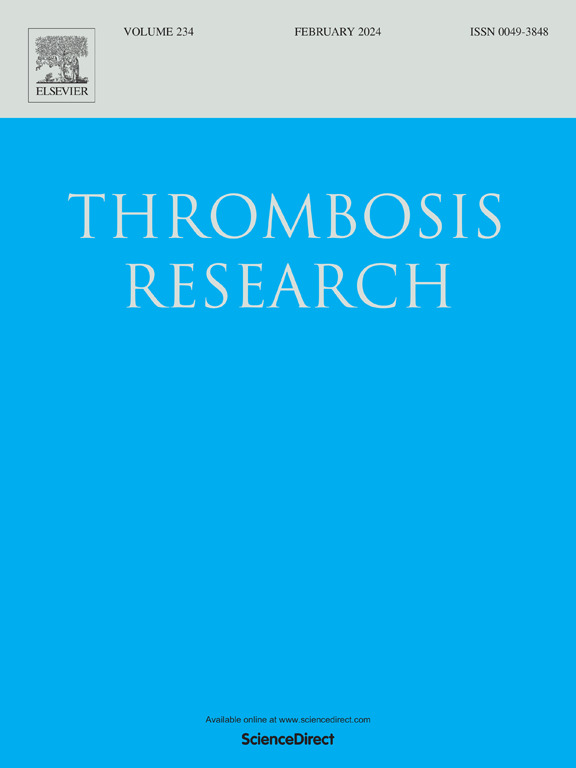慢性肾脏疾病不同阶段凝血特征的比较评价:一项横断面研究
IF 3.4
3区 医学
Q1 HEMATOLOGY
引用次数: 0
摘要
背景和目的慢性肾脏疾病(CKD)患者,特别是终末期肾脏疾病(ESRD)患者易发生出血和血栓形成。我们的目的是评估几个止血参数,并确定不同阶段CKD患者凝血过程的差异。方法本横断面研究包括2至5期CKD(非透析)患者和血液透析(HD)或腹膜透析(PD)的ESRD患者。进行标准凝血试验,以及血栓弹性成像(TEG)和血小板功能分析(PFA)。结果共纳入148例患者,平均年龄65.6±14.3岁;75%男性;76%是高血压。在所有组中,特别是CKD 2期和5期,在d -二聚体、FVIII、同型半胱氨酸、纤维蛋白原、血管性血友病因子(vWF)、aPTT和TEG参数(最大振幅[MA]、K时间、A角)方面存在显著差异,随着CKD的进展,这些值逐渐增加(均p <; 0.05)。PD组和HD组在FVIII、vWF、PFA和TEG参数上存在较大差异,PD患者高凝性更强。PFA值与TEG参数无关,而血小板计数与PFA和MA值均相关。eGFR独立预测了大部分的凝血和TEG参数。结论CKD的进展影响TEG、PFA和大多数凝血检查,表明即使在CKD的早期阶段也存在血栓形成前的特征。此外,HD和PD患者的凝血参数存在显著差异,后者表现出更明显的高凝状态。考虑到研究的局限性和可能的混杂因素,这些结果应谨慎解释。本文章由计算机程序翻译,如有差异,请以英文原文为准。
Comparative evaluation of coagulation profiles across different stages of chronic kidney disease: A cross-sectional study
Background and aims
Patients with chronic kidney disease (CKD), especially those with end stage renal disease (ESRD) are prone to both bleeding and thrombosis. We aimed to evaluate several hemostasis parameters and identify any differences in the coagulation process among patients with CKD at different stages.
Methods
This cross-sectional study included patients with CKD stages 2 to5 (non-dialysis) and ESRD patients on hemodialysis (HD) or peritoneal dialysis (PD). Standard coagulation tests were performed, along with thromboelastography (TEG) and platelet function analyze (PFA).
Results
A total of 148 patients were included in the analysis, mean age 65.6 ± 14.3 years; 75 % males; 76 % hypertensive. Significant differences were identified across all groups, particularly between CKD stages 2 and 5, in D-Dimers, FVIII, homocysteine, fibrinogen, von Willebrand factor (vWF), aPTT and TEG parameters (maximal amplitude [MA], K time, A angle), with values progressively increasing as CKD advanced (all p < 0.05). The PD and HD groups had major differences in FVIII, vWF, PFA and TEG parameters, with PD patients being more hypercoagulable. PFA values did not correlate with TEG parameters, while platelet count correlated with both PFA and MA values. eGFR independently predicted most of the coagulation and TEG parameters tested.
Conclusion
CKD progression affects TEG, PFA, and most coagulation examinations, indicating a prothrombotic profile even in the early stages of CKD. Moreover, significant differences in coagulation parameters are observed between HD and PD patients, with the latter exhibiting a more pronounced hypercoagulable state. These results should be interpreted cautiously, considering the limitations and the possible confounders of the study.
求助全文
通过发布文献求助,成功后即可免费获取论文全文。
去求助
来源期刊

Thrombosis research
医学-外周血管病
CiteScore
14.60
自引率
4.00%
发文量
364
审稿时长
31 days
期刊介绍:
Thrombosis Research is an international journal dedicated to the swift dissemination of new information on thrombosis, hemostasis, and vascular biology, aimed at advancing both science and clinical care. The journal publishes peer-reviewed original research, reviews, editorials, opinions, and critiques, covering both basic and clinical studies. Priority is given to research that promises novel approaches in the diagnosis, therapy, prognosis, and prevention of thrombotic and hemorrhagic diseases.
 求助内容:
求助内容: 应助结果提醒方式:
应助结果提醒方式:


